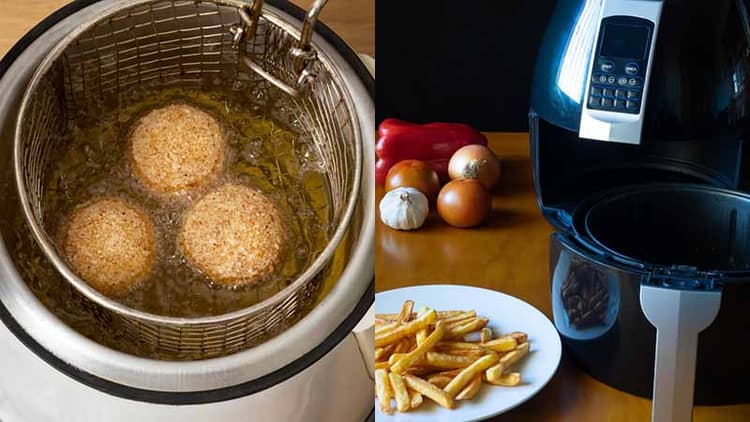Frying vs Air Frying: Which Cooking Method Is Healthier For You?
21 months ago
4 minute read.

The argument between air-frying and classic frying has been going on for ages. Both promise that delicious, crispy goodness we all love, but they do it in very different ways. They have their pros and cons, but which one comes out on top in terms of health benefits?
Classic frying is all about dunking food in hot oil until it's perfectly crispy. Think about your favorite fried chicken or those golden French fries – they're classic fried delights. But here's the thing: too much oil can lead to health problems like obesity and heart disease because of all the extra calories and unhealthy fats.
Now, air frying is a newer method that's changing the game. Instead of oil, air fryers use hot air to give you that same crispy texture with way less fat and calories. It's like magic! But some people wonder if air frying can match the taste and texture of classic frying.
How Does Cooking Affect Food?
Before diving into the comparison between frying and air frying, it's crucial to understand how different cooking methods impact food. When food is subjected to high temperatures, various chemical reactions occur. Frying, for instance, involves submerging food in hot oil, which can lead to the formation of potentially harmful compounds like trans fats and acrylamide.
On the other hand, air frying relies on hot air circulation to cook food. This method significantly reduces the formation of harmful compounds compared to traditional frying while still achieving desirable textures and flavors.
Also read: Secrets To Cooking Healthier!
Traditional Frying
Traditional frying involves immersing food in hot oil, leading to rapid cooking and the development of a crispy exterior. This method, revered for its ability to enhance flavor and texture, has been a cornerstone of culinary practices across cultures for centuries. However, its health implications warrant scrutiny.
Pros:
- Flavor and Texture Enhancement: The immersion of food in hot oil results in a delightful crispiness and a rich, indulgent flavor that is often unmatched by other cooking methods.
- Quick and Convenient Cooking: Frying facilitates rapid cooking, making it an ideal choice for busy individuals or occasions requiring prompt meal preparation.
- Versatility: From savory delights like fried chicken and French fries to sweet treats like doughnuts and churros, the versatility of frying allows for the preparation of a wide array of dishes to suit various tastes and preferences.
Also Read: Can Fried Food be Your Friend?
Cons:
- High Caloric Content: The absorption of oil during frying significantly increases the calorie content of the cooked food, potentially contributing to weight gain and obesity when consumed excessively.
- Formation of Harmful Compounds: Heating oil to high temperatures can lead to the formation of trans fats and oxidized cholesterol, which are associated with an increased risk of cardiovascular diseases.
- Potential Carcinogenic Risk: Frying starchy foods at high temperatures can result in the formation of acrylamide, a potentially carcinogenic compound linked to an elevated risk of cancer.
Air Frying
Air frying is a cooking method that utilizes hot air circulation to cook food, often employing a minimal amount of oil or sometimes none at all. This technique involves a compact countertop appliance called an air fryer, which generates hot air up to 400°F (200°C) to crisp and cook foods. The result? Deliciously crispy textures akin to traditional frying but with significantly less oil.
Pros:
- Reduced Oil Usage: Air frying requires significantly less oil than traditional frying, resulting in lower calorie and fat content in the cooked food while still achieving a desirable crispy texture.
- Healthier Nutritional Profile: With reduced oil intake, air-fried foods are generally lower in unhealthy fats, making them a preferred option for individuals monitoring their dietary fat intake or concerned about cardiovascular health.
- Less Acrylamide Formation: Cooking at lower temperatures in an air fryer reduces the risk of acrylamide formation compared to deep frying, mitigating potential carcinogenic risks associated with this compound.
Cons:
- Altered Texture: While air-fried foods do develop a crispy exterior, they may exhibit a slightly different texture compared to their traditionally fried counterparts, which could be a consideration for those with specific culinary preferences.
- Initial Investment: Acquiring an air fryer represents an initial financial investment, although the potential long-term health benefits and versatility of the appliance may justify the cost for individuals committed to healthier cooking practices.

Frying vs. Air Frying: Which Is Better for Health?
When it comes to health considerations, air frying emerges as the superior option. By significantly reducing oil usage and minimizing the formation of harmful compounds, air frying offers a healthier alternative to traditional frying. It allows you to enjoy crispy and flavorful foods with fewer calories and less risk to your health.
However, it's essential to note that the overall healthiness of your meal isn't solely determined by the cooking method. Factors such as the types of foods you're cooking, portion sizes, and overall dietary patterns also play significant roles in determining the nutritional quality of your meals.
Also Check: Healthy Cooking Tips for Healthier You
In conclusion, while both frying and air frying have their merits, the latter stands out as a healthier option without compromising on taste and texture. By understanding the implications of different cooking methods and considering your personal preferences and health goals, you can make informed choices that contribute to a healthier lifestyle in the kitchen.
Leave a Comment
Related Articles
Health Checks @ Home
Service
Explore
© 2026 Truworth Health Technologies Pvt. Ltd.





